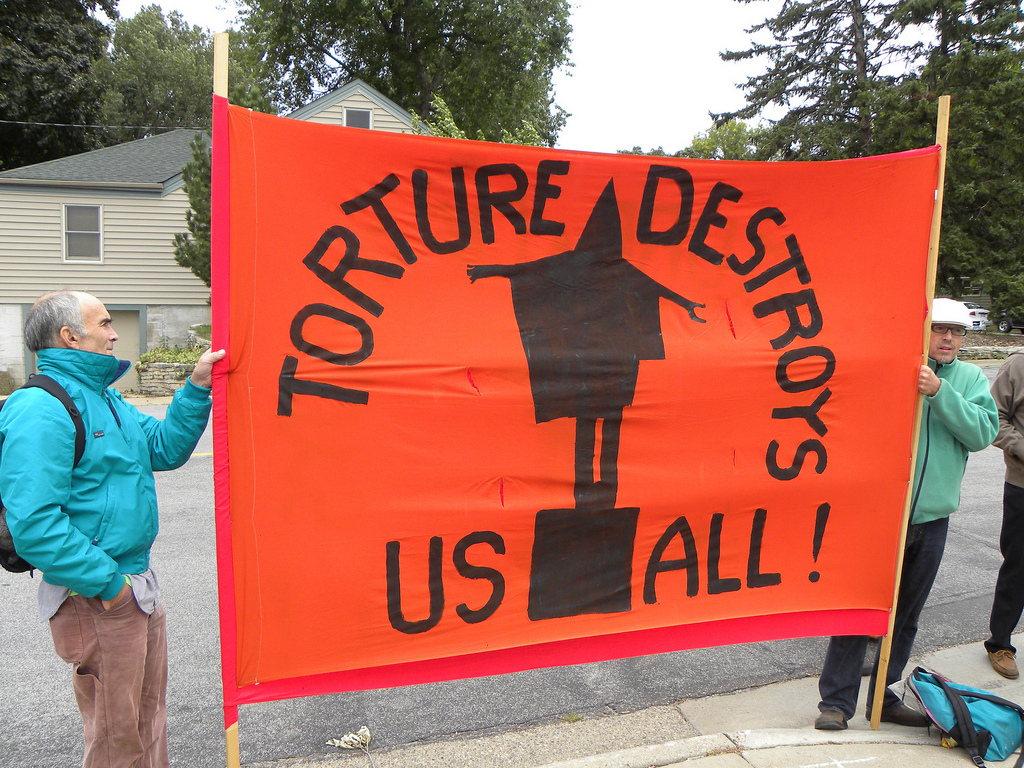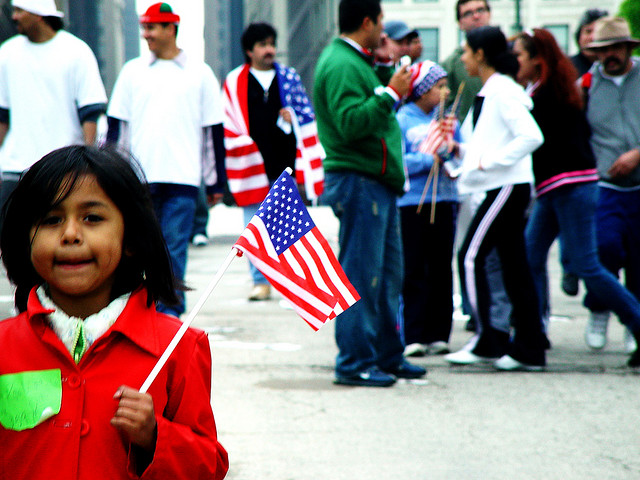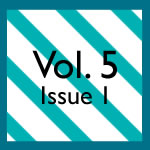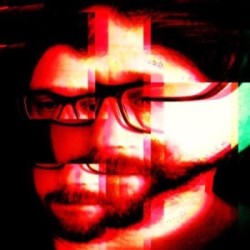Ecologies of Race in the Public Rhetoric Classroom
Setting the Scene
Talking about race is easy; talking about it well is hard. Teaching it seems downright impossible both inside and outside of courses focused exclusively on it (recent events at Mizzou, just down the road from here, bear this out). Nevertheless, there are moments when we are compelled as teachers (of rhetoric) to take up race and racism as matters of concern. Teaching in Saint Louis, MO, in the Fall of 2014 (in a public rhetoric course), I was so moved—twenty minutes away from peaceful, and at times violent, protests that were daily in the news and fifty feet away from protesters occupying campus around the clock tower just outside the building in which I was teaching. The university was becoming a focal point, its actions in welcoming protesters on campus and letting them stay coming under intense public scrutiny.
Presented here, in formally revised versions of original course content, are three ways I pedagogically worked through race in terms of rhetoric. I have kept the original content of the texts to capture both where I was at in that moment and how I responded in and to the moment kairotically. I have remediated the form of that content to better, more affectively perform what I was doing and the goals I set for it. I begin by grounding the texts, these moments, in the concerns of the course: public rhetoric as a symbolic and material activity.
I turned to rhetorical ecologies because that was the operating theory within the course, which, as a production-based course, did not involve either much reading or much discussion of theory. In other words, rhetorical ecology was ready at hand; however, as I am here reflecting upon this course, I have layered in more explicit, critical engagements with race in the classroom and African-American rhetoric itself. This layering is partial and risks superficiality. As I will shortly be teaching this course again, I am also writing this piece to my future self in order to make that course better the second time around.
The wide net I constructed and cast evidences my attempt to develop several ways into race—ways to construct teachable moments that worked within the terminology of the course, with which the students were becoming familiar and comfortable. As the title suggests, my approach both in public rhetoric and its intersections with race is the theoretical and methodological framework of rhetorical ecologies, in particular the work of Jenny Rice on rhetorical ecologies and inquiry as social action. Rhetorical ecologies works well to describe rhetorical activity that does not follow official channels or otherwise well-worn rhetorical ruts. (Ryan Weber and I have previously used rhetorical ecologies to trace the Montgomery Bus Boycott.)
In her first formulation of rhetorical ecologies in “Unframing Models of Public Distribution: From Rhetorical Situation to Rhetorical Ecologies,” Rice (then Edbauer) writes:
Our rhetorical theories can thus acknowledge the affective channels of rhetorical communication and operation by “testifying” to them. Such testimonies would invent new concepts and deploy them in order to theorize how publics are also created through affective channels. (21)
These testimonies would account for rhetorical interaction beyond the neat and tidy boundaries of the rhetorical situation in which all the elements are discrete. In terms of race, such an atomistic perspective would seek the singular causes of racism rather than account for racism’s emergence and distribution across networks. This work of testifying, while under the name of inquiry, gets fully fleshed out in Distant Publics:
Instead of seeking resolution, the inquiring subject seeks to uncover the composition of a given scene (What are the relations that give it shape and form?). The subject is implicated within the process, and that relational position is also revealed in the act of investigation. Most importantly, the goal of inquiry is not always resolution. (169)
I aimed for the investigatory rather than the accusatory, in line with Audrey Thompson’s work on antiracist teaching. Thompson cautions against “Addressing racism as a form of prejudice” as this line of argument “takes the problem to be a matter of mistaken beliefs, lies, ignorance, and/or undemocratic sentiments such as hatred or intolerance for members of particular social groups” (8). Thompson continues:
If racism is not a problem attributable simply to ignorance, mistaken beliefs, or individual character flaws, but instead is an organizing principle of our society and culture, education intended to challenge racism needs to adopt a different framework from that offered by liberal education. (8)
I found, in the case of my public rhetoric course, that an ecological approach provides such a framework. It resists abstracting individuals from the scenes they find themselves embedded in. In tracing relations, our own positions become no less precarious as anyone else’s. Rice connects inquiry, which she treats as social action, to the idea of “sustainable futures”: the stakes are high for such collective, rhetorical work. Such futures “demand that we think about ourselves as beings who exist in multiple and asymmetrical networks. Intervention must also happen within networks; public subjects are never single” (164). In this context, “inquiry is an endless survey of these networks within which a crisis is embedded” (168). While not endless, the goal of surveying networks within crisis drove the work I did within this public rhetoric course. Rice’s articulation of inquiry resonates again with Thompson when Thompson writes that an active, pedagogical stance against racism “cannot merely correct for racism but must help reorient us in ways that enable us to rework and rethink race relations” (9). Rice argues that “tracing a network requires one to reflect on the relational processes and linkages that form a network” (171): such is the activity I attempted as a teacher and in the work described below.
First, I examine a moment of civil disobedience that made use of place and public infrastructure. A group of protesters attempted to block a major interstate in Saint Louis County (of which the city of Saint Louis is not a part). Law enforcement responded in force. I analyzed this act of civil disobedience in terms of spatial rhetoric. Throughout this webtext, I use epigrams from both Rice and Frederick Douglass to, in part, frame all of these moments. Douglass’s rhetoric, which I return to in the conclusion, attends explicitly to spatial as well as bodily rhetorics. This moment I present as a short video that allows the audience to keep the images I worked with front and center.
The second instance is ecological and more properly discursive: how do we talk about race and how has that discourse been shaped by a confluence of other events, actors, and forces rather than simply individual prejudice or other simplistic causal attributions? How can rhetorical exigence be understood more complexly? This move can again be understood in the terms Thompson provides for antiracist education: “the framework I will assume regards racism as institutional and structural as well as embodied and cultural” (9). This moment, then, also worked against creating the impression that my goal as the instructor in this conversation was to root out and diagnose racism among students. It positioned the conversation as investigatory rather than accusatory. This I present as a webtext to put the links collected to work.
The third and final moment arrived immediately following the now widely discussed grand jury verdict. This moment of addressing race became, as will be seen, a moment to reconsider the need—the desire—to address something at all. The rush to make meaning and to label, sort, divide and decide, so common after moments of great consequence, forecloses on more productive rhetorics, such as those I attempted to perform earlier in the semester. I present this moment as a podcast to both capture its epideictic qualities and to compel listening upon the audience.
Moment One: Protest Mechanics
September 11, 2014
For nearly a week I spoke every day in this old post office to audiences constantly increasing in numbers and respectability, ‘til the Baptist church was thrown upon to me; and when this became too small I went on Sunday into the open Park and addressed an assembly of four or five thousand persons. (Douglass 1079)
The political potential of network inquiry lies in its ability to imagine new relations, thus creating a new network of meanings. (Rice 172)
Transcript PDF
Moment Two: Complex Causation
October 13, 2014
I never rise to speak before an American audience without something of the feeling that my failure or success will bring blame or benefit to my whole race. (Douglass 1083)
Networks are not about fixed indexes of meaning but about relations among elements. (Rice 170)
The overnight news is just in, and the protesters are already thinning out. Though some do remain, the march on and occupation of Saint Louis University’s (SLU’s) campus is part of a longer and larger march through the streets of the St. Louis area as part of #FergusonOctober.
These overnight hours, I suspect, have something to teach us about public rhetoric: not just the march itself as public rhetoric—but the rhetoric of how the march moved, how it came to campus, and how and why it stayed on campus. The people who stood and the tents that now stand around the clock tower reveal the complex workings of public rhetoric. Public rhetoric is best understood not as singular acts performed in singular moments but rather as an ongoing flux of elements that momentarily emerge and cohere into discernible acts.
Here, in list fashion, are some of those elements (a list that was updated throughout the semester). These elements are neither isolated nor linear; they are part of an ecology wherein each animates the other. They produce effects as a collective, and those effects change as the elements shift in relation to one another. We could arrange the list in any number of ways, and each pattern would impact the whole. How and where and why we discuss race matters; there isn’t one conversation about race but rather an ecology of discourses shaping and responding to one another.
- This Economic Policy Institute Report on the public policy roots of Ferguson, MO
- The shooting death of Michael Brown
- #FergusonOctober
- Ferguson October gather at Chaifetz Arena
- SLU’s Midtown Location
- SLU’s status as private property
- SLU’s prominent status in Midtown
- The Gates around SLU’s campus
- SLU’s Department of Public Safety
- Student IDs
- SLU policies on guests
- SLU’s Jesuit Mission
- President Pestello’s recent inaugural address, which featured a renewed commitment to issues of justice surrounding events like those in Ferguson
- This Post-Dispatch Story
- This Washington Post Story
- This New York Times Story
- This NBC News Story (note inflammatory headline)
- This BizPac Review Story (note inflammatory headline and content)
- #OccupySLU and #SLU
- SLU’s decision to allow the protesters access to campus
- Interactions between students and protesters
- The President’s letter to SLU community in response to the march
- The arrest of Cornell West
- Teach-In at SLU
- Agreement Reached with #OccupySLU
- This Washington Post Story on Saint Louis County
There are all of these and of course more equally effective/affective elements. Our collective and individual sense of this protest, the meaning it creates, and the material impact it will have, emerge from the interaction of these elements. These interactions might very well conflict, cohere, or contrast with one another. For instance, President Pestello’s letter speaks to the security of the campus (reassuring students and parents, faculty and staff) as well as its mission, which some might see as in conflict with one another. The purpose of campus security could be seen as protecting students, staff, and faculty from outside harm; the purpose of the university’s mission is to confront outside harms in order to promote justice. The letter, if viewed as a positive step (which, full disclosure, is how I read it), functions so, in part, because SLU is a private campus routinely patrolled by its own officers and, in many spots, enclosed by fences. In other words, that SLU could choose to allow the protesters on campus or not is far from insignificant. Indeed, the private nature of SLU’s campus in concert with its relative prominence in Midtown Saint Louis might very well be what drew protesters to campus.
More can and should be said here. Always. How and where and why we discuss race matters. There isn’t one conversation but an ecology of discourses shaping and responding to one another.
Since this original list was posted, SLU signed a thirteen-point agreement with demonstrators that has become known as the “Clock Tower Accords.” Additionally, and even more recently, university officials removed a statue from campus (“Where the Rivers Meet”) that depicts Jesuit missionary Pierre-Jean De Smet praying toward two Native Americans in traditional dress. The decision to remove this statue can be traced, in part, to the accords, one of which calls for a “Mutually agreed upon commissioned artwork.”
Moment Three: Public Listening
November 25, 2014
Undertaking to fight my way through the crowd with a stick which I caught up in the melee, I attracted the fury of the mob, which laid me prostrate on the ground under a torrent of blows. Leaving me thus, with my right hand broken, and in a state of unconsciousness, the mobocrats hastily mounted their horses and rode to Andersonville, where most of them resided. (Douglass 1081)
Inquiry is the rhetorical goal. (Rice 173)
Conclusion: Implicating Discomfort
Summer 2015
We get caught up with the individual. We avoid the large. Racism is becoming more taboo than politics and religion as subjects for casual conversation. (Victor Villanueva 3)
There is, looking back, a trajectory here moving ever more intensely into the core of the course. It looks to me like a teacher settling in and a group of students becoming increasingly receptive. What I have offered, then, is less an employable set of texts, lessons, or advice, and more the performance of a teacher coming to terms with race in pedagogy both during and after the course. I see that what I have done is (re)turn to rhetoric. That is, the move to discuss race simply meant following through on the complex principles and practices of a public rhetoric course rather than a thing that one tries to “incorporate” into the classroom. Traditions of African-American rhetoric provide guidance here. As my epigrammatic use of Frederick Douglass suggests, since its earliest formulations African-American rhetoric attends to place and to bodies—to materiality in ways necessary for a fuller understanding of rhetoric. Of Douglass’s narrative, Cynthia Nielsen writes, “Douglass took advantage of this [racial] antagonism and created educational sites wherever he went”(264). In his treatment of Douglass in terms of space and surveillance, Felix Haase writes to demonstrate “how the architecture of Baltimore’s city space leads to a loosening of surveillance and allows Douglass to become literate” (71). African-American rhetoric brings bodies and place to rhetoric in unusual ways. Of the many selections in Patricia Bizzell and Bruce Herzberg’s The Rhetorical Tradition, the selections from Douglass are one the few places where place and bodies are discussed and articulated as important to rhetoric. Douglass writes of securing venues, moving from town to town, and how all of this movement was affected by the constant threat of bodily harm. Rhetoric does well to attend to the distinction between the closed fist and the open hand, but it needs also attune itself to the broken right hand of Douglass’s African-American rhetoric. In short, a course on public rhetoric cannot simply incorporate race, but must be built from an understanding of rhetoric already informed by the work of African-American rhetors and rhetoricians.
I likewise pause here at the end to reflect on my own original hesitation to deal with race and racism in my classroom. Is it that I didn’t want to potentially offend my students and polarize my class? Is it that I felt the need to protect myself as an untenured professor? Or was it something else entirely? Given the curiosity and receptivity of my students—their eagerness to collaboratively make sense of these events—and my institution’s own outspoken and mission-based support of the protesters, the first two rationales seem increasingly unlikely as genuine causes for concern. If I felt hesitant, I wasn’t picking it up from the ambient environment on campus. No, for now I am left with other possibilities, which are my own to explore. As I move to ready this course for another set of students, then, I keep in mind Audrey Thompson when she writes, “anti-racist pedagogy is both personal and political. It asks us to become the kind of persons who can respond to as-yet-unimagined racial possibilities” (35).
Works Cited
- Douglass, Frederick. “From The Life and Times of Frederick Douglass.” The Rhetorical Tradition. Ed. Patricia Bizzell and Bruce Herzberg. New York: Norton, 2001. 1079-84. Print.
- Edbauer, Jennifer. “Unframing Models of Public Distribution: From Rhetorical Situation to Rhetorical Ecologies.” Rhetoric Society Quarterly 35.4 (2005): 5-24. Print.
- Haase, Felix. “‘Within the Circle’: Space and Surveillance in Frederick Douglass’s Narrative of the Life of Frederick Douglass, an American Slave.” aspeers 8 (2005): 71-88. 21 May 2015. Web. 12 May. 2015.
- Nieilsen, Cynthia R. “Resistance Is Not Futile. Frederick Douglass on Panoptic Plantations and the Un-Making of Docile Bodies and Enslaved Souls.” Philosophy and Literature 35.2 (2011): 251-68. Print.
- Rice, Jenny. Distant Publics: Development Rhetoric and the Subject of Crisis. Pittsburgh: U of Pittburgh P, 2012. Print.
- Rivers, Nathaniel, and Ryan Weber. “Ecological, Pedagogical Public Rhetoric.” College Composition and Communication 63.2 (2011): 187-218. Print.
- Thomson, Audrey. “For: Anti-Racist Education.” Curriculum Inquiry 27.1 (1997): 7-44. Print.
- Villaneuva, Victor. “Blind: Talking about the New Racism.” The Writing Center Journal 26.1 (2006): 3-19. Print.




 Nathaniel A. Rivers (
Nathaniel A. Rivers (